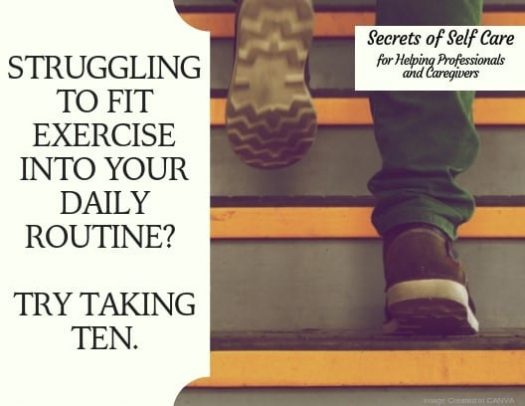Written By: Alicia Cassels
If you struggle to find time to fit exercise in your daily routine, you are not alone.
According to the Centers for Disease Control and Prevention (CDC), only about 20 percent of adults meet the 2018 physical activity guidelines for their age group. For healthy adults ages 18-64, that consists of at least 150 minutes of moderate physical activity each week and strengthening activities that work all major muscle groups at least 2 days each week. Given the demands of daily life and the multiple responsibilities that helping professionals and caregivers manage, it is no wonder that prioritizing time to engage in physical activity can present challenges. Yet the risks associated with failing to incorporate the recommended physical activity are simply too great to ignore. Leading health agencies consistently report that a lack of physical activity leaves adults at greater risk for Heart Disease, Stroke, Type 2 Diabetes, Depression, and High blood pressure (CDC 2018, U.S. Department of Agriculture, 2015, U.S.).
Achieving the recommended weekly physical activity offers important health benefits.
According to the CDC (2017), ‘There are numerous health benefits related to physical activity. These health benefits include a lower risk of chronic diseases such as diabetes, heart disease and stroke, some cancers, and depression.’
Being physically active can also help you sleep well, improve mobility, achieve and maintain a healthy weight, and strengthen muscles and bones (U.S. Department of Agriculture, 2015). Beginning an exercise routine may seem daunting. The good news? It is okay to start small. In fact, incorporating brief activity intervals into your day may help you build a more physically active lifestyle.
Consider taking ten.
Whether at work or at home, adding physical activity in small, consistent increments may serve as a great entry point for adding physical activity into your daily routine. According to the U.S. Department of Veterans Affairs (n.d.), short bursts of moderate or vigorous physical activity several times a day, ‘add up to a good plan for caregivers in obtaining moderate exercise, providing important health benefits.’
If you’re engaging in moderate or vigorous physical activity for at least 10 minutes at a time, this activity contributes to your weekly activity total. Moderate and vigorous physical activity causes you to breathe harder and makes your heart beat faster. Physical activity is considered moderate if you are able to speak while doing them but unable to sing. With vigorous physical activity, you will be able to say just a few words without taking time to catch your breath (CDC 2018).
Ready to get started?
The Mayo Clinic offers great tips to increase exercise during the work day.
1. Start with your commute.
Walk or bike to work. If you ride the bus or the subway, get off a few blocks early or at an earlier stop than usual and walk the rest of the way. If you drive to work, park at the far end of the parking lot — or park in a nearby lot. In your building, take the stairs rather than the elevator.
2. Stand up and work.
Look for ways to get out of your chair. Stand and walk while talking on the phone. Or try a standing desk — or improvise with a high table or counter. Eat lunch standing up. If possible, skip instant messaging and email, and instead walk to a colleague’s desk for a face-to-face chat.
3. Take fitness breaks.
Rather than hanging out in the lounge with coffee or a snack, take a brisk walk, hike a few flights of stairs or do some gentle stretching. For example, face straight ahead, then lower your chin to your chest. Or, while standing, grab the back of one of your ankles — or your pant leg — and bring it up toward your buttock. Hold each stretch for 15 to 30 seconds.
4. Join forces.
Organize a lunchtime walking group. Enjoy the camaraderie of others who are ready to lace up their walking shoes. You can hold each other accountable for regular exercise — and offer encouragement to one another when the going gets tough.
5. Conduct meetings on the go.
When it’s practical, schedule walking meetings or walking brainstorming sessions. Do laps inside your building, or if the weather cooperates, take your walking meetings outdoors.
Click here to read all 10 Mayo Clinic Tips.
References
“10 Easy Ways to Work out While You Work.” Mayo Clinic, Mayo Foundation for Medical Education and Research, 10 May 2017.
“National Caregiver Training Program Caregiver Workbook.”. U.S. Department of Veterans Affairs. n.d.
“Physical Activity Basics.” Centers for Disease Control and Prevention, 29 Aug. 2018.
“Why Is Physical Activity Important?” U.S. Department of Agriculture, 10 June 2015.
“Worksite Physical Activity.” Centers for Disease Control and Prevention, 28 Sept. 2017.




![Blog Post Image: Pexels [Silhouette Photo of Jumping Children, photo by Margaret Weir, Sept. 22, 2017, CC0]](https://oneop.org/wp-content/uploads/2024/04/pexels-margaret-weir-620530-600x403.jpg)










